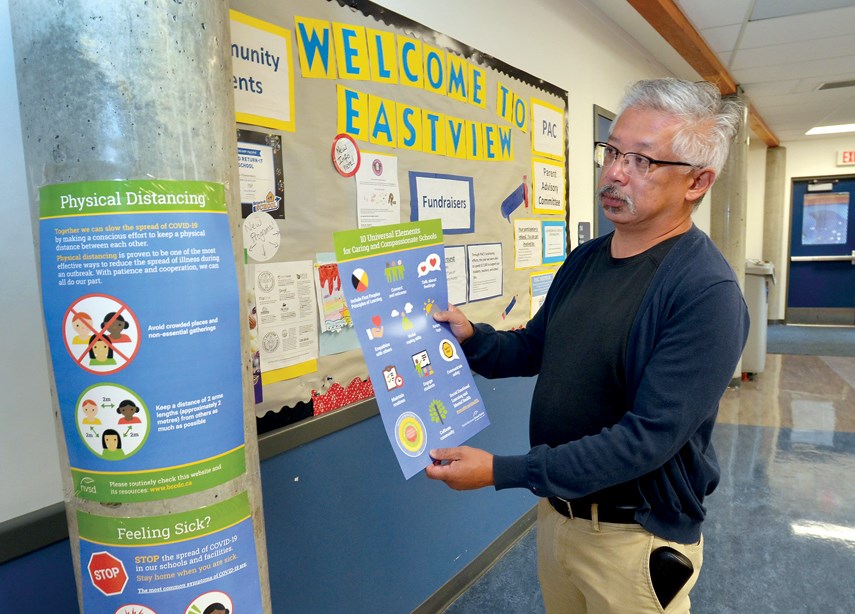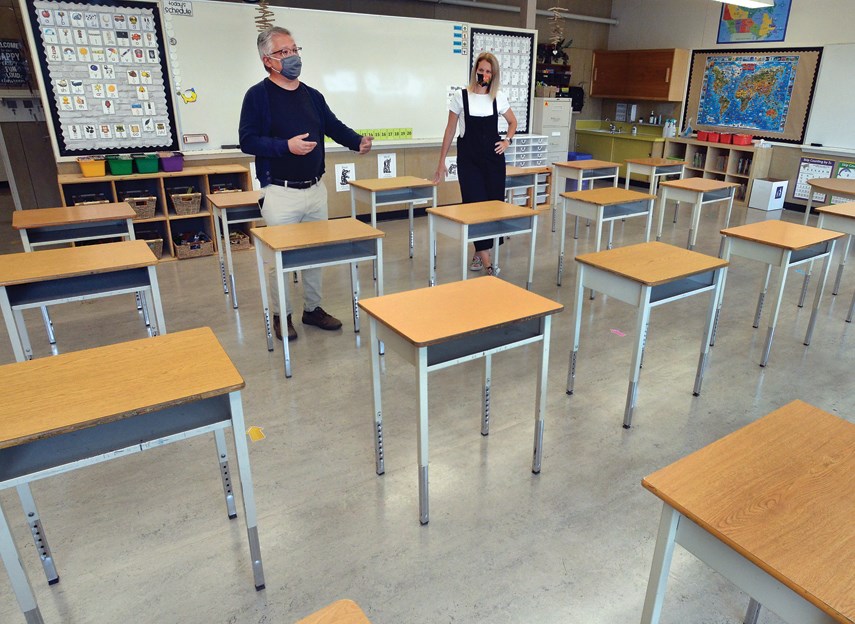Nicky Mey usually doesn’t get this excited about hand washing. However, as a Grade 2/3 teacher (and vice-principal) at Eastview Elementary, she can’t wait to see how her plan to keep students safe will play out on the first day of school.
Luck is with her in two ways. Like many of the teachers here, she has two doorways leading into her North Vancouver classroom. This makes it possible to have students come in one door and out the other, reducing the risk of bottlenecks. She also has a sink right next to the “in” door, perfect as a hand-washing station. But, since students are going to be washing their hands up to 10 times a day, she also doesn’t want coronavirus prevention protocols eating into too much of her teaching time.
So here’s how she envisions the start to her students’ day. As soon as they arrive at the school, the students will gather outside at their class’s designated area. Mey will greet them as they wait for the morning bell. (Luck is also on the school’s side; there are enough exterior doors to allow various entry points that keep each class physically distanced from one another in the hallways. At Eastview, at least, there’s no need for a staggered start.)
One by one students will follow her into the classroom where they will spend the bulk of their day. They’ll get a spray of soap on their hands and then follow the arrows along the aisle at the back of the room. They’ll take off their coats and hang up their backpacks on their individual hook, continuing to chatter with one another as they round the corner and follow the arrows back to the sink, all while wash, wash, washing their hands.
“It’s like a hand-washing train,” Mey says.
It’s also an example of how school staff, both at Eastview and throughout the North Vancouver School District, have been coming up with ways to keep students and staff safe during a pandemic that is made worse by close physical contact.

There are about 300 students enrolled in the school that’s tucked into the trees in a quiet residential neighbourhood. More than 80 per cent of them will back in class September 11, five days a week for a full day of instruction.
Principal Rick Chan sees this as a sign of the trust parents have in staff to keep their children safe, but also recognition of what the nationwide school shut down last March reinforced to families and educators alike.
“School is much more than book learning and instruction,” he says. “Schools are important community hubs. Social interaction is critical to our individual and collective well-being and mental health.”
Chan and Mey, along with North Vancouver School District communications manager Lisa Dalla Vecchia, took the North Shore News for a tour of the school in late August. Teachers were still in the midst of organizing their classrooms to conform with provincial hygiene and physical distancing rules while making sure the classrooms were welcoming environments.
Many of the new protocols were in place in June, when almost two-thirds of students returned for a month of in-class education. Those protocols have been tweaked and enhanced to limit the chances of students coming into close contact with others outside their “core”, aka their class.
Signage on walls and floors is now more plentiful and uniform. Tape covers drinking fountains. Hallways and classrooms are being decluttered, with excess supplies being stored on the school stage (which will no longer be in use.) There are posters everywhere to encourage students to follow the new rules. Some staircases are only for going up; some are for going down.
“Children are extremely flexible and adaptable,” Mey says. “They just need to know that there's a clear way. We demonstrate it, we model it for the children all the time. They're looking at us for guidance — we've got this; you've got this.”
Once inside their classroom, the students do not need to remain two metres apart from one another, although physical contact is being minimized. Each student will have their own supplies at their desk. There’s no sharing of scissors or glue sticks, for instance. There will be fewer chances that they will touch something that another student has touched. Hand-washing will be routine.
Surfaces will be washed down before students stay in their classroom to eat lunch. Recess and play time will always be outside so parents should make sure their children come dressed for all types of weather. Recess and lunch will be staggered in two groups but, Chan says, efforts have been made to facilitate children being able play outside with friends who aren’t in their class.
Instead of having students go to the library or music room, the librarian and music teacher will be bringing their programs into the classrooms. During this time, teachers can leave to do their prep work in either the staff room or the converted activity room, allowing them to remain two metres away from each other.
Masks are not mandatory inside the classroom. When physical distancing isn’t possible outside the classroom, masks will be required. The school board has procured two washable polyester/Spandex masks for every staff member and student. They come in two sizes: K to Grade 5 and Grade 6 onwards.
The district has also hired extra custodial staff to clean high-touch surfaces such as door knobs and toilet handles twice a day. “The protocols for cleaning are much more strict compared to pre-COVID times,” Chan says.
“Having seen what our district team has been planning,” he adds, “I think there will be great security and comfort in knowing what's going to be in place. There's always that fear of the unknown, but things are being planned in a very meticulous way.”
If coronavirus infection levels rise beyond a comfortable level and the province closes schools again, the district has embraced the Microsoft Teams platform for remote learning. Earlier experience should make the transition to at-home instruction much easier.
For students who, for various reasons, are opting not to come back to the school, Dalla Vechhia says “we will come up with an alternative because we do want to see all families comfortable [with the new learning environment.] We will ensure that there's continuity of education for their children in one way, shape or form.”
It’s taken a lot of work to come up with a new way of providing education to students during a pandemic. “We're all going through this together,” Dalla Vecchia says. “We're all having to be flexible and nimble, with compassionate understanding of each other.”
Creating a sense of belonging and care for the students is what education is all about, Chan says. “That’s why it's so important to have students back in the building because the learning is so much more than just the literacy and numeracy. Our district has a social/emotional learning group team that has thoughtfully planned how to nurture the social emotional aspect of our students’ lives. There's no doubt that there are changes for our students. Making sure that they feel connected, making sure that their worries are addressed, making sure people understand and empathize and sympathize is a huge part of what we do.”
That sense of caring extends to staff as well. “Throughout our school district,” he says, “we work as a collective group. We support one another — compassion is a huge piece. There's flexibility, there's understanding.
“The pandemic is a societal challenge. It's not lost on us that a school is such an important part of the community and we're leaders in our community. Every single staff member takes the role and responsibility so seriously. I know I feel very honoured in being part of this community here.”
Martha Perkins is the North Shore News’ Indigenous and civic affairs reporter. This reporting beat is made possible by the Local Journalism Initiative.



